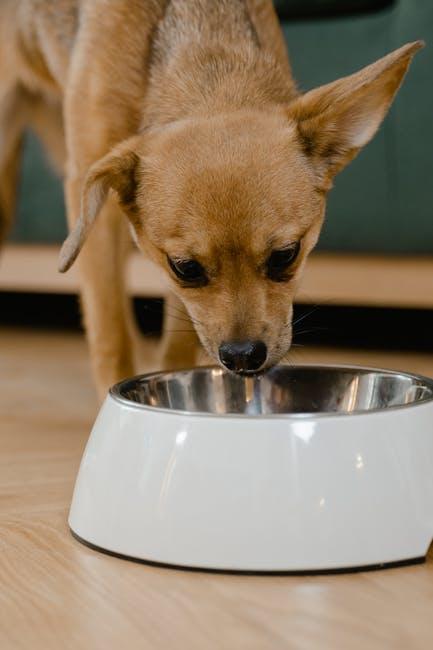Ensuring your furry friend stays healthy and happy is a top priority for any dog owner, and one of the most crucial yet often overlooked aspects of canine health is proper hydration. Just like humans, dogs rely on adequate water intake to maintain essential bodily functions, from digestion and nutrient absorption to temperature regulation and joint lubrication. In this article, we will explore the importance of hydration in dogs, shedding light on the signs of dehydration, the benefits of keeping your pup well-hydrated, and practical tips to encourage regular water consumption. With a warm and caring approach, we aim to equip you with the knowledge needed to ensure your beloved companion thrives with the vitality and joy that a well-hydrated life brings.
Recognizing the Signs of Dehydration in Your Furry Friend
Ensuring your dog stays well-hydrated is crucial for their overall health and happiness. However, recognizing when your furry companion is dehydrated can sometimes be challenging. Here are some signs to watch for:
- Sunken Eyes: If your dog’s eyes appear dull or sunken, it might be an indication of dehydration.
- Lethargy: A sudden lack of energy or enthusiasm for activities they usually enjoy could signal that your dog needs more water.
- Dry Nose and Gums: A healthy dog should have a moist nose and gums. If these areas are dry or sticky, dehydration might be the cause.
- Loss of Skin Elasticity: Gently pinch a small amount of skin on your dog’s back. If it doesn’t spring back into place quickly, your dog may be dehydrated.
By staying vigilant and recognizing these signs early, you can ensure your furry friend remains hydrated and healthy. Remember, a well-hydrated dog is a happy dog!

Ensuring Optimal Hydration for Different Breeds and Sizes
When it comes to keeping our furry friends hydrated, understanding the unique needs of different breeds and sizes is essential. Large breeds like Great Danes or Saint Bernards have higher water requirements due to their size and often higher levels of activity. On the other hand, smaller breeds such as Chihuahuas or Pomeranians, though needing less water may require more frequent hydration breaks throughout the day.
- Large breeds: Ensure they have access to a constant supply of fresh water, especially after exercise.
- Small breeds: Consider multiple water stations in your home to encourage frequent drinking.
- Active dogs: Increase water intake to compensate for the loss through panting and physical activity.
- Sedentary dogs: Monitor water consumption to prevent dehydration due to less obvious thirst cues.
Understanding these distinctions not only promotes better health but also helps prevent issues such as dehydration or urinary tract infections. By tailoring hydration practices to suit the individual needs of your dog, you ensure they remain happy and healthy companions.
Creative Ways to Encourage Your Dog to Drink More Water
Keeping your furry friend well-hydrated can sometimes be a challenge, but there are plenty of fun and innovative methods to make sure they sip up. Turn water time into playtime by introducing a pet-friendly fountain. These devices not only keep water fresh but also attract curious pups with the sound of flowing water. Ice cube treats are another engaging option. Simply freeze low-sodium chicken broth or a splash of unsweetened apple juice into cubes for a refreshing, flavorful surprise.
- Flavored Water: Add a small amount of bone broth or tuna juice to their water bowl for a tasty twist.
- Wet Food Addition: Mixing wet dog food with water can increase their fluid intake seamlessly.
- Interactive Toys: Use toys that dispense water or can be filled with water-based treats.
- Multiple Water Stations: Place several water bowls around the house and yard to encourage frequent drinking.
By incorporating these creative strategies, you can ensure your dog stays happy, healthy, and hydrated all day long.
Choosing the Right Water Sources for Your Canine Companion
Ensuring your dog has access to clean and safe water is a cornerstone of their health and well-being. When selecting a water source for your furry friend, consider options that are both convenient and beneficial to their health. Here are some tips to help you make the best choice:
- Tap Water: Generally safe for dogs, but it’s wise to check local water quality reports to ensure there are no harmful contaminants.
- Filtered Water: Using a filter can remove impurities like chlorine and lead, offering a cleaner alternative.
- Bottled Water: While convenient, ensure it’s from a reliable source and free of added minerals that could affect your dog’s health.
- Natural Sources: Exercise caution when letting your dog drink from streams or ponds, as these can contain bacteria or parasites.
Remember, the key is to provide fresh water daily, as stagnant water can become a breeding ground for bacteria. Monitor your dog’s water intake, especially during hot weather or after exercise, to keep them happy and hydrated.

